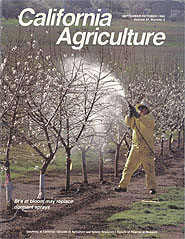All Issues

Bt's at bloom may replace dormant sprays
Cover:
The insect pathogen Bacillus thuringiensis proved effective in controlling peach twig borer on almonds, peaches and nectarines, offering a possible alternative to dormant organophosphates. Watne Johnson, staff research associate at UC Davis, is shown spraying Bt in a Colusa County almond orchard.
Photo by Jack Kelly Clark
September-October 1993
Volume 47, Number 5
Volume 47, Number 5





